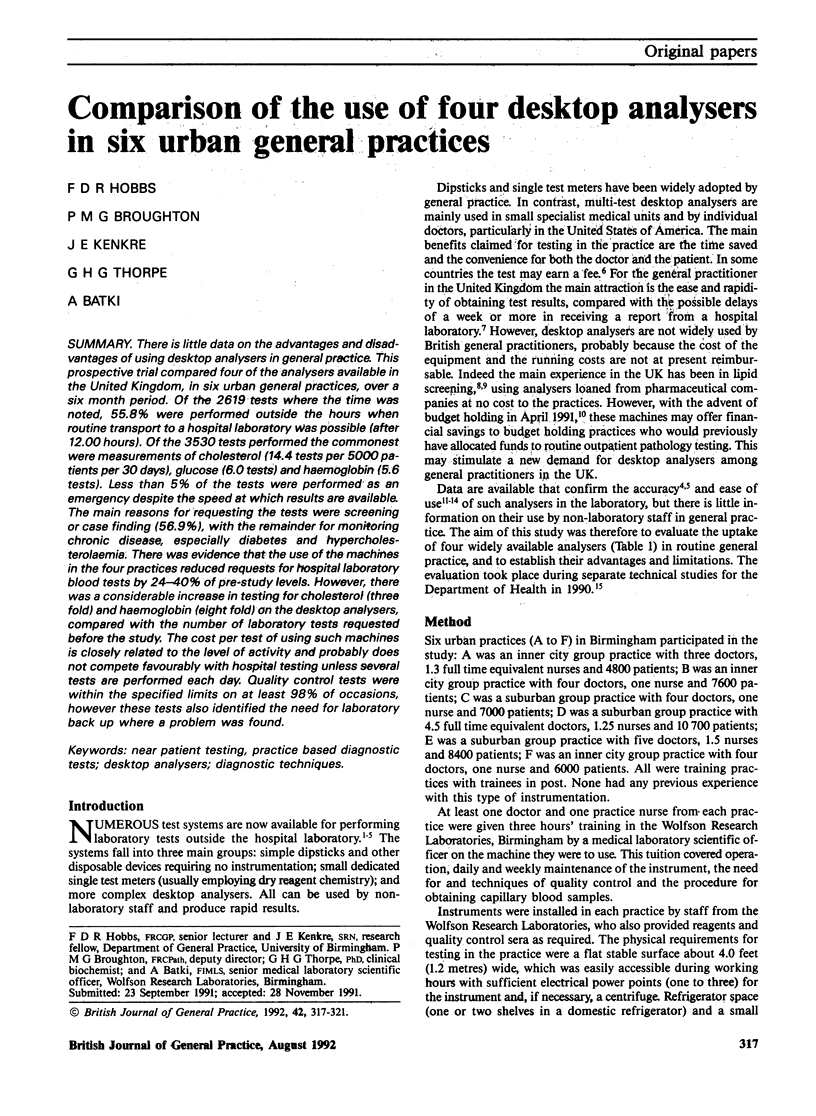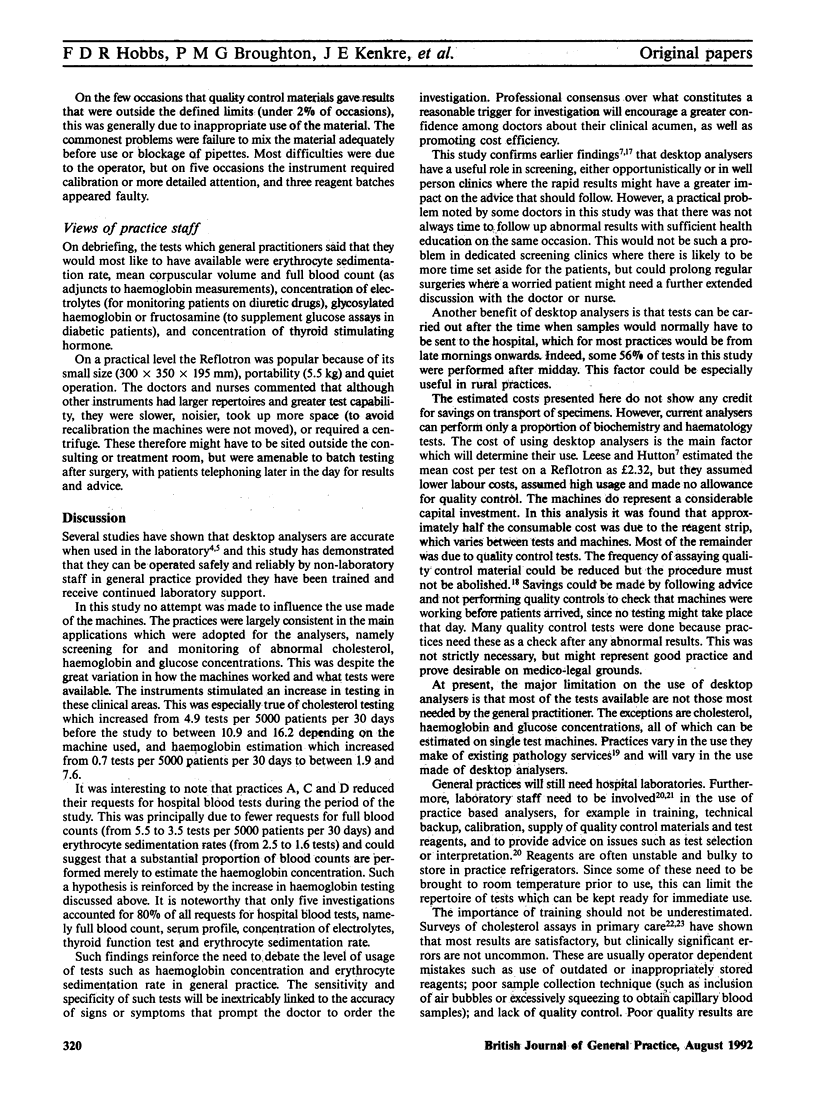Abstract
There is little data on the advantages and disadvantages of using desktop analysers in general practice. This prospective trial compared four of the analysers available in the United Kingdom, in six urban general practices, over a six month period. Of the 2619 tests where the time was noted, 55.8% were performed outside the hours when routine transport to a hospital laboratory was possible (after 12.00 hours). Of the 3530 tests performed the commonest were measurements of cholesterol (14.4 tests per 5000 patients per 30 days), glucose (6.0 tests) and haemoglobin (5.6 tests). Less than 5% of the tests were performed as an emergency despite the speed at which results are available. The main reasons for requesting the tests were screening or case finding (56.9%), with the remainder for monitoring chronic disease, especially diabetes and hypercholesterolaemia. There was evidence that the use of the machines in the four practices reduced requests for hospital laboratory blood tests by 24-40% of pre-study levels. However, there was a considerable increase in testing for cholesterol (three fold) and haemoglobin (eight fold) on the desktop analysers, compared with the number of laboratory tests requested before the study. The cost per test of using such machines is closely related to the level of activity and probably does not compete favourably with hospital testing unless several tests are performed each day. Quality control tests were within the specified limits on at least 98% of occasions, however these tests also identified the need for laboratory back up where a problem was found.
Full text
PDF




Selected References
These references are in PubMed. This may not be the complete list of references from this article.
- Anggard E. E., Land J. M., Lenihan C. J., Packard C. J., Percy M. J., Ritchie L. D., Shepherd J. Prevention of cardiovascular disease in general practice: a proposed model. Br Med J (Clin Res Ed) 1986 Jul 19;293(6540):177–180. doi: 10.1136/bmj.293.6540.177. [DOI] [PMC free article] [PubMed] [Google Scholar]
- Belsey R., Baer D., Sewell D. Laboratory test analysis near the patient. Opportunities for improved clinical diagnosis and management. JAMA. 1986 Feb 14;255(6):775–786. [PubMed] [Google Scholar]
- Broughton P. M., Bullock D. G., Cramb R. Improving the quality of plasma cholesterol measurements in primary care. Scand J Clin Lab Invest Suppl. 1990;198:43–48. [PubMed] [Google Scholar]
- Broughton P. M., Bullock D. G., Cramb R. Quality of plasma cholesterol measurements in primary care. BMJ. 1989 Feb 4;298(6669):297–298. doi: 10.1136/bmj.298.6669.297. [DOI] [PMC free article] [PubMed] [Google Scholar]
- Broughton P. M. Laboratory medicine in primary health care. Br J Gen Pract. 1990 Jan;40(330):2–3. [PMC free article] [PubMed] [Google Scholar]
- Broughton P. M., Thorpe G. H. Laboratory testing in, or for, general practice. Med Lab Sci. 1990 Oct;47(4):304–311. [PubMed] [Google Scholar]
- Hailey D. M., Lea A. R. Developments in near-patient testing. Med Lab Sci. 1990 Oct;47(4):319–325. [PubMed] [Google Scholar]
- Hailey D. M., Lea A. R., Dunt D. R., Thomas D. W., Wyndham L. E., Maynard J. H., Reed C. S., Mudge P. Assessment of physicians' office pathology testing: organisational considerations. Med Lab Sci. 1990 Oct;47(4):251–255. [PubMed] [Google Scholar]
- Hicks J. M., Iosefsohn M. Another physician's office analyzer: the Abbott "Vision" evaluated. Clin Chem. 1987 Jun;33(6):817–819. [PubMed] [Google Scholar]
- Hicks J. M., Iosefsohn M. Hemoglobin, electrolytes, and other major clinical laboratory analytes as measured with a physician's office analyzer, the Kodak DT60. Clin Chem. 1986 Dec;32(12):2201–2203. [PubMed] [Google Scholar]
- Hilton S. Near patient testing in general practice: a review. Br J Gen Pract. 1990 Jan;40(330):32–36. [PMC free article] [PubMed] [Google Scholar]
- Jones A., Davies D. H., Dove J. R., Collinson M. A., Brown P. M. Identification and treatment of risk factors for coronary heart disease in general practice: a possible screening model. Br Med J (Clin Res Ed) 1988 Jun 18;296(6638):1711–1714. doi: 10.1136/bmj.296.6638.1711. [DOI] [PMC free article] [PubMed] [Google Scholar]
- Leese B., Hutton J. Desk top analysers in general medical practice: how useful are they? Med Lab Sci. 1990 Oct;47(4):256–262. [PubMed] [Google Scholar]
- Mills K. A., Reilly P. M. Laboratory and radiological investigations in general practice. I-Type requested and rate of use. Br Med J (Clin Res Ed) 1983 Oct 8;287(6398):1033–1036. doi: 10.1136/bmj.287.6398.1033. [DOI] [PMC free article] [PubMed] [Google Scholar]
- Price C. P., Koller P. U. A multicentre study of the new Reflotron system for the measurement of urea, glucose, triacylglycerols, cholesterol, gamma-glutamyltransferase and haemoglobin. J Clin Chem Clin Biochem. 1988 Apr;26(4):233–250. [PubMed] [Google Scholar]
- Statland B. E., Moskowitz M. A. Why office testing? Clin Lab Med. 1986 Jun;6(2):205–209. [PubMed] [Google Scholar]
- Stott N. C. Desktop laboratory technology in general practice. BMJ. 1989 Sep 2;299(6699):579–580. doi: 10.1136/bmj.299.6699.579. [DOI] [PMC free article] [PubMed] [Google Scholar]


